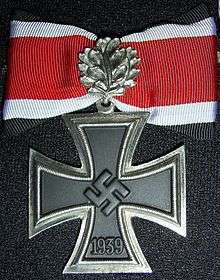Heinrich von Vietinghoff
| Heinrich von Vietinghoff | |
|---|---|
 | |
| Born |
6 December 1887 Mainz, German Empire |
| Died |
23 February 1952 (aged 64) Pfronten-Ried, West Germany |
| Allegiance | |
| Years of service | 1903–45 |
| Rank | Generaloberst |
| Commands held |
XIII Corps 15th Army 10th Army Army Group Courland |
| Battles/wars |
First World War Second World War |
| Awards | See "Military awards" section |
| Relations | Hans Hahn (son-in-law) |
Heinrich von Vietinghoff (6 December 1887 – 23 February 1952) was a German general (Generaloberst) of the Wehrmacht during the Second World War. He was a recipient of the Knight's Cross of the Iron Cross with Oak Leaves. Vietinghoff commanded the German and Italian troops in German-occupied Italy in 1945.
Military career

On 24 November 1938, Vietinghoff was appointed commander of the 5th Panzer Division and took part in the invasion of Poland under Wilhelm Ritter von Leeb. He was promoted to General in June 1940 after which he led the German XLVI Panzer Corps in the invasion of Yugoslavia.
During Operation Barbarossa his Corps was part of Army Group Centre under Field Marshal Fedor von Bock. As all commanders of the German corps on the Eastern Front during the invasion, Vietinghoff implemented the criminal Commissar Order.[1] Vietinghoff also later served with General Heinz Guderian in the 2nd Panzer Army.
From December 1941 to August 1943 he was Commander-in-Chief of the German Fifteenth Army in France (The HQ of the 15th Army is today a museum in Tourcoing, near Lille in northern France, Musée du 5 Juin 1944). In Italy from August 1943 onwards he commanded German Tenth Army, which was responsible for the telling delaying actions through the successive defensive lines built across Italy. Notable in this context were the defences on the Winter Line from November 1943 to May 1944 and the fighting in the autumn of 1944 on the Gothic Line. In October 1944 he was temporarily raised to overall command in Italy (Army Group C) when Field Marshal Albert Kesselring was seriously injured in a car crash.[2] In January 1945, on Kesselring's return, he left Italy to command Army Group Courland in East Prussia. When Kesselring was moved in March 1945 to command German Army Command West (OB West) in France, Vietinghoff returned as the supreme German commander in Italy.[3]
At the end of April 1945, he made contact with the Allied forces and on 29 April, his representative General Karl Wolff signed on his behalf at the Royal Palace in Caserta the instrument of surrender on 2 May 1945 at noon. Afterwards he spent two and a half years in British captivity at Bridgend Island Farm (Special Camp XI) among numerous other German prisoners of war. He was released in September 1947.
After the war Vietinghoff was a member of the expert group dealing with the question of German rearmament. In October 1950 he wrote the Himmerod memorandum, named after the Himmerod Abbey where it was written, on behalf of the Adenauer government, on West German contributions to European defence. He died on 23 February 1952 in Pfronten.
Military awards
- Prussian Royal House Order of Hohenzollern, Knight’s Cross with Swords - 18 April 1918
- Prussian Iron Cross (1914) 1st Class (23 April 1915) & 2nd Class (13 September 1914)[4]
- Clasp to the Iron Cross (1939) 1st Class (28 September 1939) & 2nd Class (21 September 1939)[4]
- Knight's Cross of the Iron Cross with Oak Leaves
- Knight's Cross on 24 June 1940 as General der Panzertruppe and commanding general of XIII. Armeekorps[5]
- 456th Oak Leaves on 16 April 1944 as Generaloberst and commander-in-chief of the 10. Armee[5]
- German Cross in Gold - 22 April 1942 as General der Panzertruppe and commanding general of the XXXXVI Panzerkorps[6]
See also
References
Citations
- ↑ Stahel 2015, p. 28.
- ↑ Blaxland 1979, p. 226.
- ↑ Blaxland 1979, p. 246.
- 1 2 Thomas 1998, p. 400.
- 1 2 Scherzer 2007, p. 759.
- ↑ Patzwall & Scherzer 2001, p. 486.
Bibliography
- Blaxland, Gregory (1979). Alexander's Generals (the Italian Campaign 1944-1945). London: William Kimber & Co. ISBN 0-7183-0386-5.
- Patzwall, Klaus D.; Scherzer, Veit (2001). Das Deutsche Kreuz 1941 – 1945 Geschichte und Inhaber Band II [The German Cross 1941 – 1945 History and Recipients Volume 2] (in German). Norderstedt, Germany: Verlag Klaus D. Patzwall. ISBN 978-3-931533-45-8.
- Scherzer, Veit (2007). Die Ritterkreuzträger 1939–1945 Die Inhaber des Ritterkreuzes des Eisernen Kreuzes 1939 von Heer, Luftwaffe, Kriegsmarine, Waffen-SS, Volkssturm sowie mit Deutschland verbündeter Streitkräfte nach den Unterlagen des Bundesarchives [The Knight's Cross Bearers 1939–1945 The Holders of the Knight's Cross of the Iron Cross 1939 by Army, Air Force, Navy, Waffen-SS, Volkssturm and Allied Forces with Germany According to the Documents of the Federal Archives] (in German). Jena, Germany: Scherzers Miltaer-Verlag. ISBN 978-3-938845-17-2.
- Stahel, David (2009). Operation Barbarossa and Germany's Defeat in the East. Cambridge, UK: Cambridge University Press. ISBN 978-0-521-76847-4.
- Thomas, Franz (1998). Die Eichenlaubträger 1939–1945 Band 2: L–Z [The Oak Leaves Bearers 1939–1945 Volume 2: L–Z] (in German). Osnabrück, Germany: Biblio-Verlag. ISBN 978-3-7648-2300-9.
| Military offices | ||
|---|---|---|
| Preceded by none |
Commander of 5th Panzer Division 2 September 1939 – 8 October 1939 |
Succeeded by Generalleutnant Max von Hartlieb-Walsporn |
| Preceded by General Walter von Reichenau |
Commander of 10. Armee 15 August 1943 – 14 February 1945 |
Succeeded by General Traugott Herr |
| Preceded by General Lothar Rendulic |
Commander of Army Group Courland 27 January 1945 – 10 March 1945 |
Succeeded by General Lothar Rendulic |
| Preceded by Generalfeldmarschall Albert Kesselring |
Oberbefehlshaber Süd 11 March 1945 – 2 May 1945 |
Succeeded by none |
